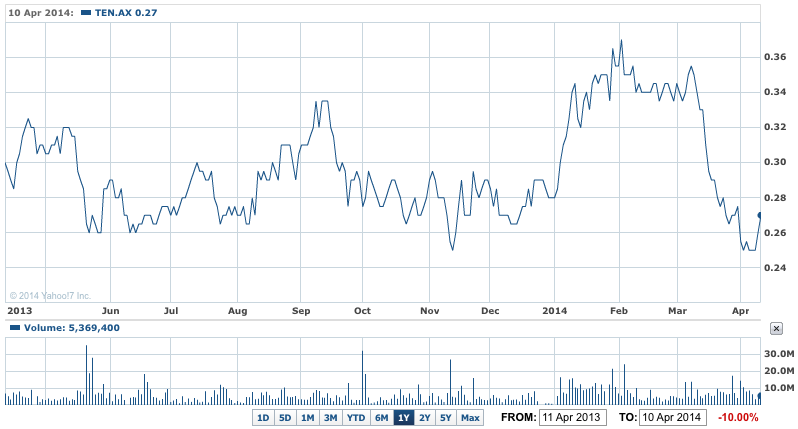It wasn’t a good interim result from the Ten Network (TEN) yesterday and the outlook for the rest of the year is looking pretty poor.
There’s no dividend again for shareholders and the loss after tax was lower when compared to the previous half year figure which was boosted by more than $340 million in write downs and losses.
Remove those from the comparison, and the result was worse, thanks to a surge in costs.
Ten wasn’t confident about the second half of its financial year saying "Advertising market conditions remain “short”, with many advertisers reluctant to commit to long-term campaigns. As a result, the outlook for the television advertising market is uncertain at this stage."
It admitted that its general entertainment programming had not kicked on after the Winter Games in Sochi, as the network had hoped.
In fact the outlook for its programs is not good given the way the network’s nightly viewing share has slid to record lows in the past three weeks.
Nine and Seven would be a bit more upbeat about their outlooks – they are confident of lifting revenues (even by small amounts) and at least earning a steady net profit.
Ten isn’t even in the same league – net profit – that’s a strange beast for the network.
But then Seven and Nine have the programs to do this – My Kitchen Rules, The Block, The Voice and House Rules – all mega hits.
The big bonus for Ten is that debt has been slashed to just $36 million and it has the special $200 million in financing from the Commonwealth Bank (that will cost several millions a year in fees over four years to each of the big guaranteeing shareholders – Murdoch, Packer and Gordon).
In the next month or so, Ten has the 2014 version of Masterchef Australia and Offspring to bring back to its schedule, plus the Glasgow Games. If Masterchef can’t at least match 2013’s weak ratings, then Ten is in real trouble.
Apart from the 5pm Eyewitness News, and perhaps The Project, nothing else is working for Ten at the moment on its main channel, which is where the overwhelming majority of earnings and revenues are taken.
But it has to convince departed viewers to return (very hard when they are not watching), and hold on to the loyal viewers still with the network and not alienate them. But it has money to finance new programs in the back half of this year and into 2015. It is the last chance for Ten.
TEN 1Y – Ten’s weak result; future looking tougher

Looking at the result we find that while TV revenue rose 3.2% to $316 million in the six months to the end of February, the detailed accounts filed with the ASX revealed that little of this came from higher advertising revenue. Directors said in their report "Revenue for the TV segment was up 3.2% to $316.3 million, due to increased affiliate fees and other income".
Not a word about higher ad revenues, though executive chair Hamish McLennan did say in yesterday’s press release, “Our television revenue growth was ahead of the growth rate for the capital-city free-to-air television advertising market during the six months to February 28.
“That result was driven by the successful launch of the KFC T20 Big Bash League, which gave TEN its best summer ratings since 2008, and the XXII Olympic Winter Games in Sochi, Russia. But, as expected, the increase in revenue did not off-set the investment in critical new content,” he said.
The reference to the higher affiliate income refers to the deal Ten did with Southern Cross, its regional affiliate, which resulted in Southern Cross agreeing to pay Ten a higher proportion of its revenue. That extra income drops straight to the profit and loss account’s bottom line, though in Ten’s case, much of it was chewed up by higher spending.
While Ten said that TV earnings before interest, tax, depreciation and amortisation were $10.1 million, the directors report shows that was down from the $34.9 million earned in the six months to February 2013, and that EBIT (earnings before interest and tax) fell to just $2.6 million in the latest half year, from $27.145 million a year ago.
These were more indicative of its true performance than the reported net loss after tax of just under $8 million (compared to the loss-boosted $243 million figure a year earlier). The latest result was just plain weak with no discernible boost from The Big Bash or the Winter Games.
A major reason for the worse result (besides the weak ratings at the end of 2013) was the sharp rise in costs associated with The Big Bash T20 cricket over summer and the Sochi Winter Olympics in February. They lifted costs 8.2%, or around $38 million to just over $311 for the half year. That more than accounted for the $24 million or so in higher revenues and other income in the half year.
Some of that spending (for the Sochi Games) can’t be recovered. The costs for The Big Bash can be offset against the costs of the second season next summer. Ten has the Glasgow 2014 Commonwealth Games later this year and those extra costs will be in danger of being a waste if the 2010 Delhi Games results are any guide.
Ten lost money on the Delhi Games, even though they were in a more favourable time zone for Australian TV viewing than the Glasgow games will be.
The shares rose a cent to 27c – in percentage terms that’s a rise of 3.8%. But at this level, they are not far from their all time lows, and price movements don’t mean very much.













